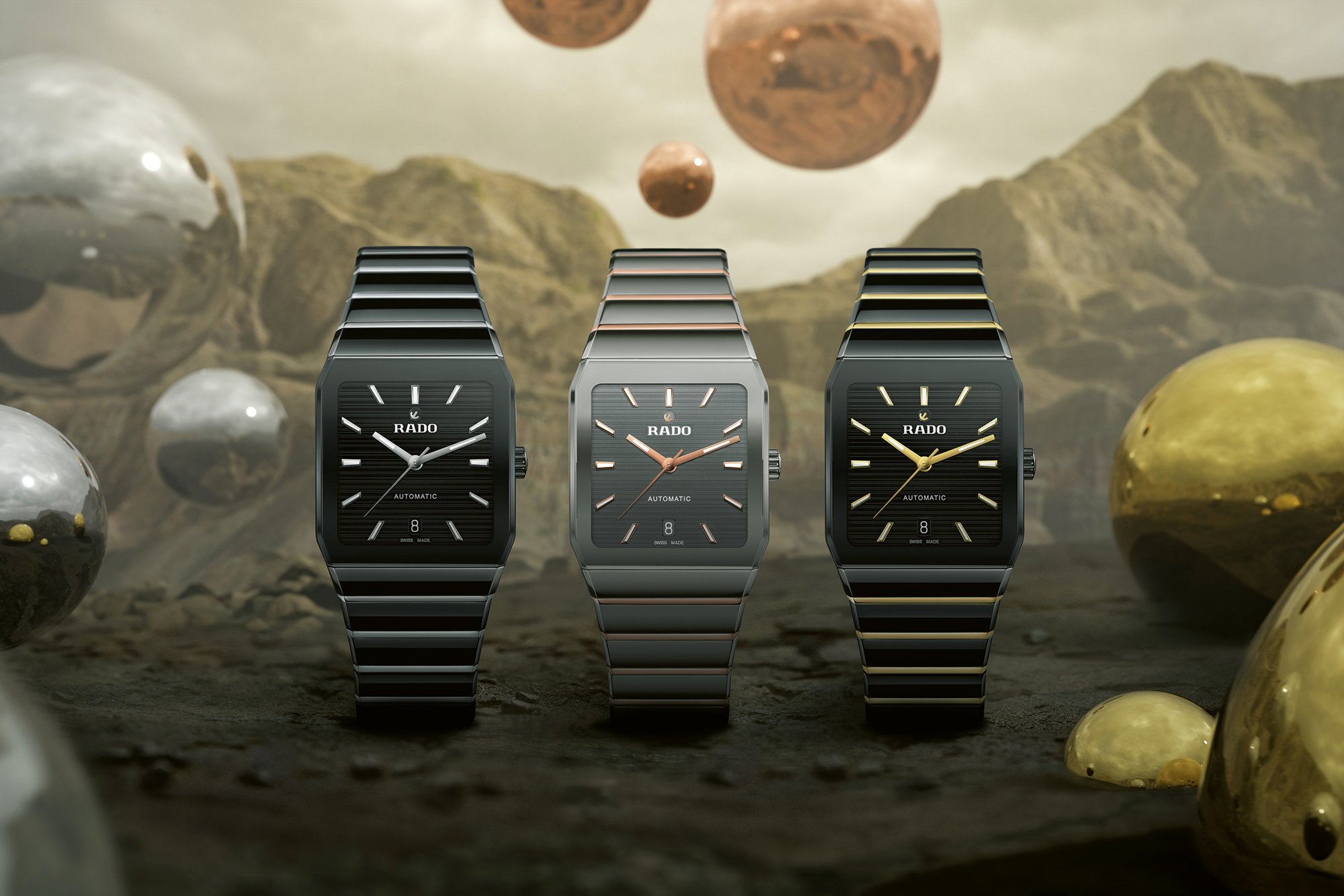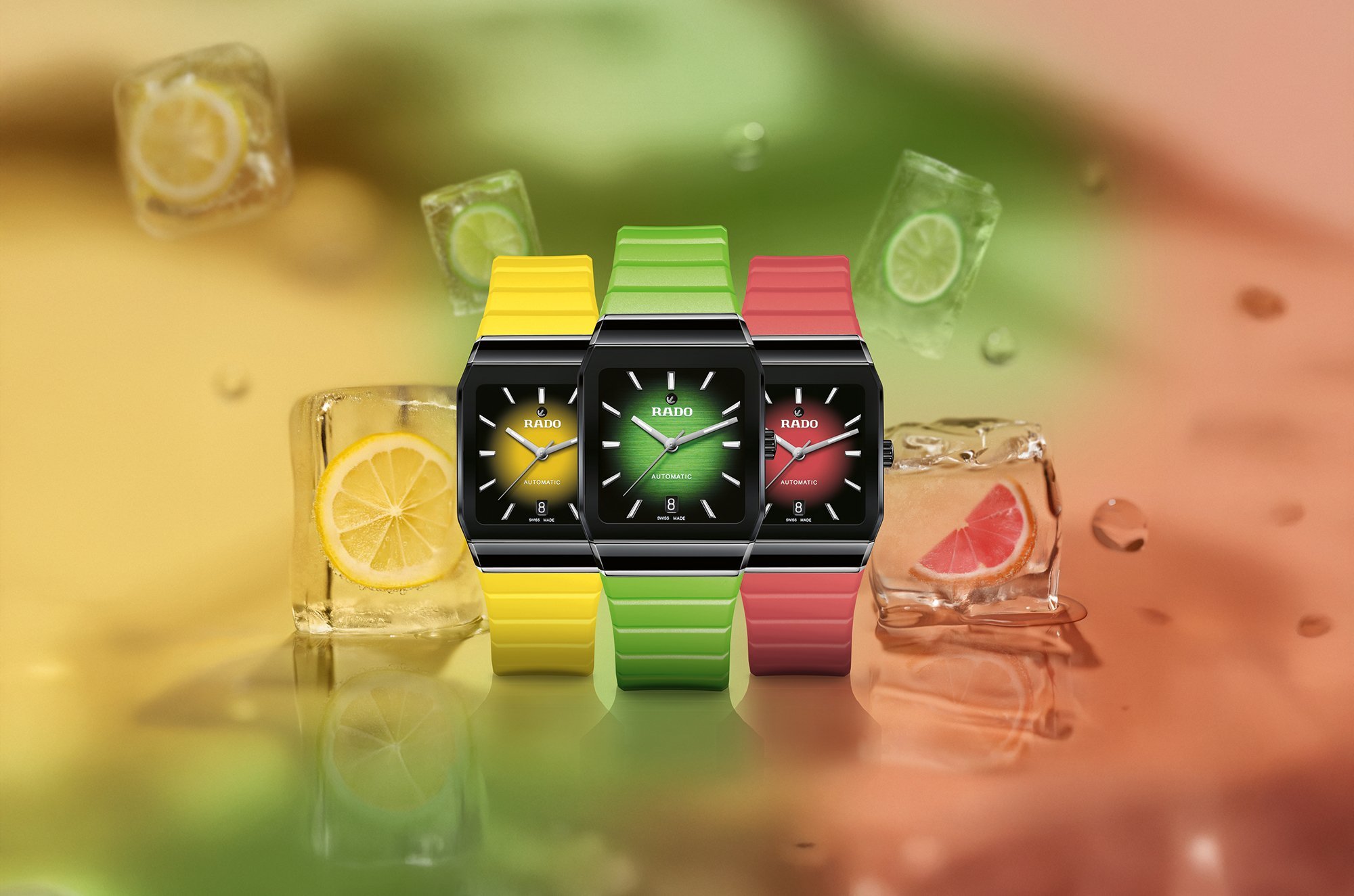here is only one way to truly appreciate the unique texture of Rado’s high-tech ceramic and that is by touch. This contact with the silky surface — remarkable, considering this is a hard metal — is a reminder that watchmaking is about physicality, finish and the art of detail in a dematerialised world. A sensory, tactile, emotional experience in which our first encounter with this living mechanical object can stay with us for the rest of our life.
High-tech ceramic — whose production subtleties we were able to observe at Comadur, part of Swatch Group — is light, smooth and adapts to changes in body temperature, and for these reasons has often been likened to a second skin.
This has always been the ultimate objective of the Rado Anatom, as its name suggests.
1983, an innovative sapphire crystal
In what was a complicated decade for the Swiss watch industry, the Anatom became one of the definitive Eighties watches, capturing attention for its wrist-hugging anatomical curves and going on to inspire the style and shape of many subsequent Rado designs.
When the Anatom launched in 1983, it immediately stood out for its ergonomic shape, which mirrors the natural curve of the wrist. As CEO Adrian Bosshard reminds us, the Anatom represented an innovative design combined with advanced research into materials. The curved sapphire crystal would be an integral part of the early Anatom.
-

- The Rado Anatom in a 1987 edition of Europa Star. The innovative sapphire crystal mirrors the natural curve of the wrist.
- ©Europa Star Archives
Paving the way for the Anatom were Rado’s earlier experimentations with square and rectangular forms, including the groundbreaking 1967 Manhattan. “The Anatom’s unique design matched the mood of the era and that is still true today,” continues Adrian Bosshard. “Every watch in the collection has a distinctive identity. The Anatom was decades ahead of the competition.” Back in the 1980s, Rado discovered that sapphire crystal could be milled and shaped into the exact required form using diamond tools. Already, the DiaStar had introduced ultimate scratch-resistance by combining a sapphire crystal with a case in Hardmetal, a super-tough tungsten carbide alloy. In fact the debut model was released as the DiaStar Anatom. While initial versions were fitted with a quartz calibre, post-1996/1997 the Anatom would be powered by a mechanical automatic movement. Hundreds of thousands were produced over the following decades. However, the gamechanger would be in autumn 2023, when Rado relaunched the Anatom still with its wrist-hugging shape and edge-to-edge convex sapphire crystal, but now with a bezel in the brand’s signature high-tech ceramic.

High-tech ceramic
The Eighties were a decade of non-stop innovation for Rado. Three years after the Anatom’s debut, in 1986 the brand revealed the result of its latest research: a completely new ceramic. This novel material stood out for its silky smooth texture, hardness, durability, scratch-resistance and surprising light weight.
Rado’s high-tech ceramic is the product of science. Under strictly regulated conditions, pure zirconium oxide powder, finely calibrated with perfectly uniform grain sizes, is moulded then baked at high temperature to create an object or a watch case with the required dimensions and properties.
New methods developed by Rado mix a polymer binder with the zirconium oxide powder, which is injected into precision moulds at a pressure of 1,000 bar. Once cooled, pieces are removed from the mould and most of the binding agent is chemically dissolved prior to a final sintering phase at 1,450°C. During this controlled sintering, the high-tech ceramic acquires its extraordinary hardness (1,250 on the Vickers scale) and density compared with regular ceramic. As the remainder of the binder evaporates and the particles bond together, the moulded part shrinks by 25% to its final size – a process that requires precise calculation. Machining with diamond tools ensures that the final dimensions are absolutely accurate.
Here comes summer!
High-tech ceramic is even more present on the Anatom watches that Rado is releasing this year, with the introduction of a bracelet forged from this innovative material. In line with the 2023 version, these new interpretations are larger than the original model, at 32.5mm wide. A more sculpted form incorporates bevelled edges for the cylindrical sapphire crystal, bezel and bracelet links. The case tapers towards the bracelet, which becomes gradually narrower to reach 20mm at the clasp. Now the entire wrist is contained in the unique feel of high-tech ceramic.
Inside, Rado’s R766 mechanical automatic movement delivers 72 hours of power reserve and is equipped with an antimagnetic Nivachron™ balance spring. There is also a date function, shown in a window at 6 o’clock.
-

- The juicy colours of the Anatom Summer
On two of the models, bezel and bracelet are made from polished black high-tech ceramic, with black ceramic for the crown. The black lacquered dial is decorated with an irregular striped pattern, complemented by yellow gold-toned or rhodium-coloured accents. A third version pairs a bezel, bracelet and crown in polished plasma high-tech ceramic with a lacquered grey dial, this time with rose gold-tone detailing. Meanwhile, diamonds lend pzazz to two Rado Jubilé versions: one with three diamonds marking 12, 3 and 9 on the minimalist dial and a second with the addition of 38 diamonds on the case plus 124 diamonds that underscore the first four links of the bracelet.

And there is more! Bang on cue for summer, Rado is releasing three colourful iterations. They of course feature the Anatom’s polished black high-tech ceramic bezel together with the edge-to-edge sapphire crystal with bevels, perfectly shaped to follow the watch’s anatomical lines, but with the colour pop of dials in fruity shades of lemon yellow, grapefruit red and lime green. Ergonomic shapes, high-tech materials and now sizzling colours: more than 40 years after its debut, the Anatom is the epitome of Rado’s “Feel It” concept. A watch close to our heart and our skin.








